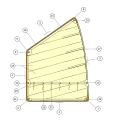Parts of a sail
In sailing the parts of a sail have certain terms that clearly describe them.[1]
There are two types of common mainsails. The Three Sided Mainsail and the Four sided Mainsail. Each of these Mainsail types have many different names according to exact location and relationship of supporting spars.
Parts of the three sided mainsail
- The head is the very top of the sail.[1]
- The tack (noun) is the name for the lower corner of the sail closest to the mast.[1] Not to be confused with a tack which describes which side of a sailboat the wind is coming from while under way—port or starboard.[2]
- The foot is the bottom edge of the sail from the tack to the clew. The foot of a sail attaches to the boom.[3]
- The luff is the forward or leading edge of a sail.[3]
- The leech is the back edge of the sail.[3]
- The clew is the bottom back corner of the sail (furthest from the mast).[1]
Parts of the four sided mainsail
- The peak is the very top of the sail.
- The throat is the top front corner of the sail.
- The tack (noun) is the name for the lower corner of the sail closest to the mast.[1] Not to be confused with a tack which describes which side of a sailboat the wind is coming from while under way—port or starboard.[2]
- The foot is the bottom edge of the sail from the tack to the clew. The foot of a sail attaches to the boom.[3]
- The head is the top edge of the sail. This is different from the three sided sail where head refers to a corner.
- The luff is the forward or leading edge of a sail.[3]
- The leech is the back edge of the sail.[3]
- The clew is the bottom back corner of the sail (furthest from the mast).[1]
Parts of a headsail
The headsail of a sailboat is any sail set forward of the mast (on a single masted boat) or foremast (the mast nearest the bow).[4] The corresponding parts are the same relative to the front of the boat. (Note: The headsail tack is the name for the lower corner of the headsail -- the sail closest to the front of the boat.)
Associated parts
- The boom is a horizontal spar (pole) that runs along the foot of a fore-and-aft rigged sail.[5]
- The jib is the next most common sail on a sailboat. It is always forward of the mainmast.
- A sheet is a rope used to control a sail.[1]
Parts Of A Sail Media
Square sail edges and corners (top), running rigging (bottom)
Genoa jib, showing reinforcement and attachment points:*1. Head 2. Reinforcement 3. Luff 4. Leech 5. Anti-UV covering 6. Headfoil attachment 7. Panel(s) 8. Telltales 9. Reinforcement 10. Tack 11. Leech control 12. Clew 13. Foot control 14. Foot 15. Furling marks
Catamaran with full-length battens in a laminated sail.
Sail detail at the tack of a mainsail, showing various types of seam stitches where panels join, bolt ropes in the luff and foot, and two cringles.
Gaff sail, showing reefing points (20) and other features.*1. Luff 2. Foot 3. Leech 4. Head 5. Throat 6. Tack 7. Clew 8. Peak 9. Throat cringle 10. Reefing cringle 11. Tack cringle 12. Clew cringle 13. Reefing cringle 14. Peak cringle 15. Reinforcing tape 16. Bolt rope 17. Batten pocket 18. Panels 19. Reef line 20. Reefing point 21. Reefing line
References
- ↑ 1.0 1.1 1.2 1.3 1.4 1.5 1.6 "Sailing Quick Reference Guide" (PDF). Wayzata Yacht Club. Archived from the original (PDF) on January 5, 2017. Retrieved December 28, 2016.
- ↑ 2.0 2.1 "Sailing Terms Everyone Should Know". American Sailing Association. November 27, 2012. Retrieved December 28, 2016.
- ↑ 3.0 3.1 3.2 3.3 3.4 3.5 Denny Desoutter, The Adlard Coles Book of Boatwords (London : Adlard Coles Nautical, 2010), p. 187
- ↑ John Keegan, The Price of Admiralty (New York: Viking press, 1989), pp. 278–279
- ↑ Mike MacKenzie (2005–2012). "Boom". Sea Talk Nautical Dictionary: The Dictionary of English Nautical Language. Archived from the original on July 2, 2016. Retrieved December 28, 2016.










